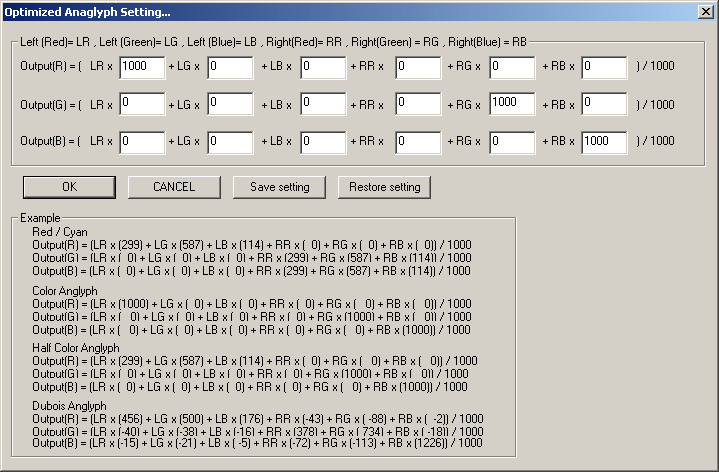

Anaglyphs do not portray saturated colors very well and, due to ' color leaking' between left and right images, this results in discomfort caused by retinal-rivalry.
One popular attempted solution ('half-color mode') is to convert the left image into its grayscale equivalent.
With some images this may still produce unacceptable results so, instead, SPM's 'Optimised Anaglyph' function may be used to 'custom tune' your own color-mixing.
SPM's 'Optimized Anaglyph Setting' dialog-box is shown above and may, at first, appear somewhat daunting.
The RGB (red, green, blue) color-derivation of the final image may be specified by the user and the settings saved.
First, let us consider what the settings would be for Anaglyph modes already supported by SPM :-
Red/Blue Monochrome Mode
Output[R] =(Left[R]x299 + Left[G]x587 + Left[B]x114 + Right[R]x0 + Right[G]x0 + Right[B]x0 ) / 1000
Output[G] =(Left[R]x0 + Left[G]x0 + Left[B]x0 + Right[R]x0 + Right[G]x0 + Right[B]x0) / 1000
Output[B] =(Left[R]x0 + Left[G]x0 + Left[B]x0 + Right[R]x299 + Right[G]x587 + Right[B]x114) / 1000
Each R,B output is simply the same average of the three color channels.
Instead of merely adding the R,G,B values and dividing by three, the proportions used are the accepted values for converting a color image
to its grayscale equivalent and are based on the radiometric sensitivity of the eye.
Normally, the entered values in each row should add up to 1000.
If greater, that color is lighter, if less then that color is darker.
If each row totalled 1500, for example, the entire image would be lighter without any color change due to the increased overall brightness.
If only the red channel values totalled 1500, the image would be brighter but redder.
So, the left eye sees a grayscale red image and the right eye sees a grayscale blue image.
All color information has been lost, the image is a bit dark but the stereo effect is good as there is little ghosting.
Red/Cyan Monochrome Mode
Output[R] =(Left[R]x299 + Left[G]x587 + Left[B]x114 + Right[R]x0 + Right[G]x0 + Right[B]x0 ) / 1000
Output[G] =(Left[R]x0 + Left[G]x0 + Left[B]x0 + Right[R]x299 + Right[G]x587 + Right[B]x114) / 1000
Output[B] =(Left[R]x0 + Left[G]x0 + Left[B]x0 + Right[R]x299 + Right[G]x587 + Right[B]x114) / 1000
Each R,G,B output is simply the same grayscale average.
So, the left eye sees a grayscale red image and the right eye sees a grayscale cyan image.
All color information has been lost, the image is brighter than red/blue anaglyphs and the stereo effect is good but with more ghosting than red/blue mode.
Color Anaglyph Mode
Output[R] =(Left[R]x1000 + Left[G]x0 + Left[B]x0 + Right[R]x0 + Right[G]x0 + Right[B]x0 ) / 1000
Output[G] =(Left[R]x0 + Left[G]x0 + Left[B]x0 + Right[R]x0 + Right[G]x1000 + Right[B]x0) / 1000
Output[B] =(Left[R]x0 + Left[G]x0 + Left[B]x0 + Right[R]x0 + Right[G]x0 + Right[B]x1000) / 1000
All of the red information of the left image is presented to the left eye and all of the blue and green information is presented to the right eye.
Color reproduction can be quite good but it is more prone to 'retinal rivalry' effects.
(white clouds in a blue sky darken nicely through the red filter and can disappear through the cyan filter).
Strongly saturated colors can produce unacceptable effects.
Color Anaglyph Half-Color Mode
Output[R] =(Left[R]x299 + Left[G]x587 + Left[B]x114 + Right[R]x0 + Right[G]x0 + Right[B]x0) / 1000
Output[G] =(Left[R]x0 + Left[G]x0 + Left[B]x0 + Right[R]x0 + Right[G]x1000 + Right[B]x0) / 1000
Output[B] =(Left[R]x0 + Left[G]x0 + Left[B]x0 + Right[R]x0 + Right[G]x0 + Right[B]x1000) / 1000
All of the blue and green information is presented to the right eye but only a grayscale representation to the left eye.
This produces less retinal rivalry but the color reproduction is not as good as 'Color Anaglyph' mode.
Optimized Anaglyph Mode
Output[R] =(Left[R]x0 + Left[G]x450 + Left[B]x1050+ Right[R]x0 + Right[G]x0 + Right[B]x0 ) / 1000
Output[G] =(Left[R]x0 + Left[G]x0 + Left[B]x0 + Right[R]x0 + Right[G]x1000 + Right[B]x0) / 1000
Output[B] =(Left[R]x0 + Left[G]x0 + Left[B]x0 + Right[R]x0 + Right[G]x0 + Right[B]x1000) / 1000
In the above example, all of the blue and green information is presented to the right eye but
none of the left image red color data has been used in deriving the output red channel.
Instead, 30% of the green channel and 70% of the blue channel are used are both are brightened by 50%.
This would eliminate rivalry caused by the red component of the image but
color reproduction is obviously not accurate.<
If subjects with saturated blue or green components are causing problems, you could try altering the color mix of the output green and blue channels.
Dubois Anaglyph Mode
Output[R] =(Left[R]x456 + Left[G]x500 + Left[B]x176 + Right[R]x-43 + Right[G]x[-88] + Right[B]x[-2] ) / 1000
Output[G] =(Left[R]x[-40] + Left[G]x[-38] + Left[B]x[-16] + Right[R]x378 + Right[G]x734 + Right[B]x[-18]) / 1000
Output[B] =(Left[R]x[-15] + Left[G]x[-21] + Left[B]x[-5] + Right[R]x[-72] + Right[G]x[-113] + Right[B]x1226) / 1000
Having arrived at suitable values for your image, you may click 'Save setting' to retain it.
In future, clicking 'Restore Setting' will re-apply the values when in Optimized Anaglyph mode.